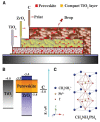Functional Materials for Fabrication of Carbon-Based Perovskite Solar Cells: Ink Formulation and Its Effect on Solar Cell Performance
- PMID: 37297051
- PMCID: PMC10253735
- DOI: 10.3390/ma16113917
Functional Materials for Fabrication of Carbon-Based Perovskite Solar Cells: Ink Formulation and Its Effect on Solar Cell Performance
Abstract
Perovskite solar cells (PSCs) have rapidly developed into one of the most attractive photovoltaic technologies, exceeding power conversion efficiencies of 25% and as the most promising technology to complement silicon-based solar cells. Among different types of PSCs, carbon-based, hole-conductor-free PSCs (C-PSCs), in particular, are seen as a viable candidate for commercialization due to the high stability, ease of fabrication, and low cost. This review examines strategies to increase charge separation, extraction, and transport properties in C-PSCs to improve the power conversion efficiency. These strategies include the use of new or modified electron transport materials, hole transport layers, and carbon electrodes. Additionally, the working principles of various printing techniques for the fabrication of C-PSCs are presented, as well as the most remarkable results obtained from each technique for small-scale devices. Finally, the manufacture of perovskite solar modules using scalable deposition techniques is discussed.
Keywords: inkjet printing; metal oxides; nanoinks; nanomaterials; screen printing; spray deposition.
Conflict of interest statement
The authors declare no conflict of interest.
Figures






















References
-
- Lin Q., Armin A., Burn P.L., Meredith P. Organohalide Perovskites for Solar Energy Conversion. Acc. Chem. Res. 2016;49:545–553. - PubMed
-
- Keremane K.S., Prathapani S., Haur L.J., Bruno A., Priyadarshi A., Adhikari A.V., Mhaisalkar S.G. Improving the Performance of Carbon-Based Perovskite Solar Modules (70 cm2) by Incorporating Cesium Halide in Mesoporous TiO2. ACS Appl. Energy Mater. 2021;4:249–258. doi: 10.1021/acsaem.0c02213. - DOI
-
- Best Research-Cell Efficiency Chart|Photovoltaic Research|NREL. [(accessed on 26 March 2023)]; Available online: https://www.nrel.gov/pv/cell-efficiency.html.
Publication types
Grants and funding
LinkOut - more resources
Full Text Sources

